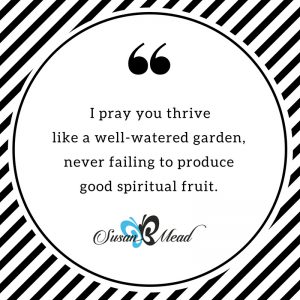This unseasonable heat makes it feel like summer in spring at my house.
Officially, it is still springtime, yet it feels like summer has arrived in full force with these 90+ degree days in North Louisiana. The reality is unseasonable heat has hit and it looks like it is here to stay.
Do you know your plants experience this rise in temperature just like we do?
So how can we help our plants handle this hot weather?
Water deeply, slowly and less frequently. Consider watering your tomatoes, vegetables and flowers – ok, your lawn too – long enough for the water to seep deep into the dirt and not just run off the top. Water deeply like this two or three times per week. The benefit of watering deeply is plant roots grow longer, deeper and further away from the hot soil surface, reducing heat stress.
How do you know you have watered deeply enough? Put a rain gauge, small stable cup or can in the garden area you are sprinkling and do not stop watering until an inch of water has been collected. It is better for the plants to get a “big drink” and be watered less frequently than a “shallow sip” more frequently, especially as temperatures rise.
This deep, slow watering plan will benefit veggies, (yes, tomatoes will love this watering program), flowers, shrubs, and lawns. The exception is container-grown plants and vegetables. Daily watering may still be required for plants in pots on hot days.
Avoid wetting plant leaves when possible. When using a sprinkler, keeping water off of the leaves is impossible, so water early in the morning. This allows the foliage to dry quickly as the daytime temperatures rise, minimizing risk of plant disease, as so many of these plant diseases require moisture to thrive.
Do whatever you can to keep the water in the ground now that you have put it there! Add organic mulch, such as pine straw, finely ground bark, chopped up leaves or whatever is commonly available in your area, in a 2 to 3 inch layer. Mulch acts like a shade cloth for the soil as the mulch holds in moisture, keeping the temperature of the soil cooler which also benefits the plant roots. Without mulch, the sun bakes the soil, causing the need for even more watering.
Learn to recognize stress in your plants. You may want to watch for an “indicator plant” – that is the first plant to wilt, indicating a need for water. Watch the big leaves in the vegetable garden – squash, cucumber or melon leaves. When losing lots of moisture these plants wilt fast, or in your flower garden it may be the hydrangea blossoms flopping or the foxglove foliage folding over that serve as your indicator it’s time to water.
Another way to help our plants handle the heat is to move container plants out of the direct sun into a shady area. Shade helps prevent the plants from drying out as rapidly and also cools the plants down. Do you know plants can sunburn just like we do? Yes indeed, so give them a break from the direct sun wherever you can.
Have you considered how fertilizing plants on a hot day may stress them out? Think about it like this – do you want to eat a big heavy meal sitting at a picnic table in the summer sun in the middle of the day? No? Neither do your plants. Do not feed your plants in the middle of a heat wave – except those tomatoes! Plan to feed them earlier in the day either prior to or as you water them.
Enjoy how those tomatoes, plants and flowers reward your efforts on their behalf!
The Lord will guide you always;
he will satisfy your needs in a sun-scorched land
and will strengthen your frame.
You will be like a well-watered garden,
like a spring whose waters never fail.
Isaiah 58:11 (NIV)
The prophet Isaiah reminds us that God satisfies our needs in a sun-scorched land..
[Tweet “I pray you thrive like a well-watered garden, never failing to produce good spiritual fruit.”]
[inlinkz_linkup id=782963 mode=1]



Thanks for linking up at Booknificent Thursday on Mommynificent.com!
Tina
I just planted a small garden for the first time in years. Thank you for the tips and for sharing at #TellHisStory.
have a blessed and enjoyable summer, Susan
Thank you for the reminder to water deep…both my garden and, I can’t help but think, my spiritual life.
When I grew tomatoes back in the day, I buried a gallon coffee can with holes punched in the bottom next to each plant. Three times a week I would use the hose to fill the coffee cans and my tomatoes turned out perfect every time (until I moved to Arizona…where the salt content of the water was too high and it prevented the plants from absorbing the water).
We have the worst luck with plants, but I bet if I took these tips into account, I’d have a much better result!!
XOXO
Jodie
http://www.jtouchofstyle.com
I’ve had to do a few of these tips, Susan. Thanks so much this is good stuff all in one place. I appreciate practical ones like this, it makes me think of mentors whom not everyone has in their life — and it can come in handy!
Hi, Susan, thanks for your watering tips. I struggle with getting it right, especially my outside plants. Probably doesn’t help that our weather can vacillate between monsoon season and heat wave in 24 hours. Hopefully, your TLC tips will enhance their beauty this summer.
Some good tips here!
I never knew plants could sunburn. How interesting!
There are always so many wonderful spiritual lessons from the physical labor of tending a garden. Praying both your physical garden and spiritual garden are thriving too, Susan!
I love that scripture! laurensparks.net
Isaiah 58 is one of my favorite chapters, and this post blesses my gardener’s heart!
I hope your June starts out well! Thanks for hosting!